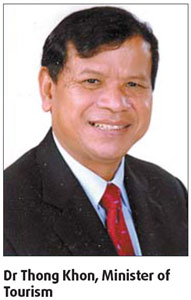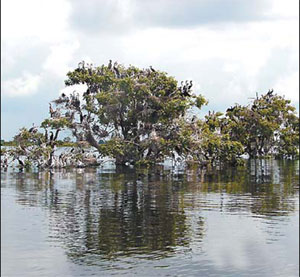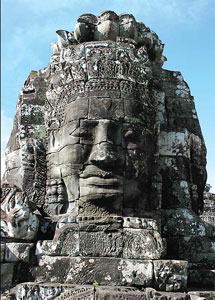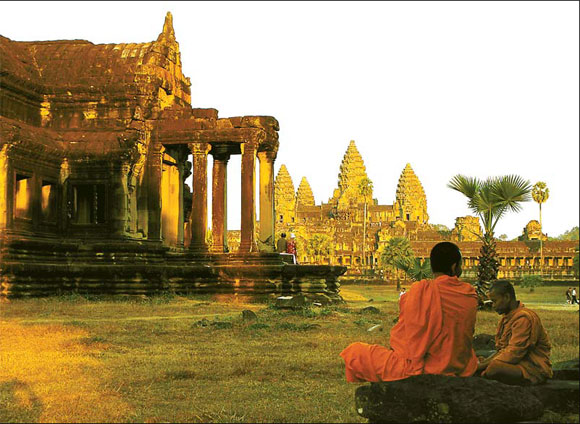Geared up to sustain tourism growth

Accounting for about 10 percent of gross domestic product, tourism has become an important pillar industry in Cambodia and is expected to experience robust growth in the years to come, the country's Tourism Minister Thong Khon told China Daily in a recent interview.
Over the past three years, tourism in Cambodia has increased at an annual rate of some 20 percent. The country saw 1.7 million tourist arrivals in 2006 and 1.8 million arrivals between January and November of 2007.
"It is now far easier to come to Cambodia as a tourism destination than ever before because the government has made great efforts to improve infrastructure," said Thong.
"Road access to airports and seaports has been improved and the highways from the bordering countries have also been developed and improved."
Cambodia has strengthened tourism promotion efforts in a bid to attract more overseas visitors.
"We have developed promotional links all over the world from London to Japan and regularly host promotional events within and outside Cambodia," Thong said.
These events include a 50-day promotional campaign in the Republic of Korea in 2006, a tourism trade show in Cambodia last October and also the hosting of the Johnny Walker Golf tournament which ran from November 29 to December 2, all of which have attracted a great deal of international attention.
Future growth
Thong predicted robust growth for Cambodian tourism in the coming years, expecting arrivals to hit 4 million in 2012.
|
A scene of the beautiful Tonle Sap Lake, where trees grow through the water |
To realize this target, the Cambodian Ministry of Tourism will coordinate with related organizations to improve tourism facilities and map out a sustainable development plan, he said.
In addition to the world-renowned Angkor Wat, the country will continue to improve the facilities of other destinations as well.
"We are trying over the coming years to do more things to attract tourists to stay for a longer period when they visit Angkor Wat. So we are improving facilities around it. Around Angkor Wat we will develop two key satellite destinations," the minister said.
Cambodia will also develop an eco-tourism zone in the northeast and the coastal region, he added.
"In conjunction with all these developments, we are trying to drive an increase in the number of hotels in the country. We do not have enough hotels to match current demand, so as demand increases substantially in the future, we will need rooms to accommodate everyone," Thong noted.
The minister admitted that lack of quality human resources is one of the biggest challenges the industry faces.
To solve the problem, the country will build more vocational and professional tourism schools, especially in major destinations like Siem Reap, Phnom Penh, and the coastal and northeast eco-tourism zones.
Sustainable development
Thong drew attention to the importance of "how we develop the tourism industry in a way that is sustainable."
For the sector's sustainable growth, the country's tourism authorities are considering mapping out a tourism master plan, he said.
"In this master plan we have to consider many areas, such as the industry's impact on the environment, overall economic development and poverty reduction."
Citing power supply in the major tourism destination of Siem Reap as an example, he said: "We are already using power supplied from Thailand to help cope with the significantly increased demand for power that will be placed upon the national grid network."
The same is true of the water supply. "Hotels and businesses in Siem Reap, for example, have been drawing water by drilling beneath the town, leading to subsidence and damage to many temples and historic monuments. So now we have put a stop to using subterranean water supplies and we are piping in water from outside the town," Thong explained.
He added that infrastructure development is also another area the authorities are focusing on, so the road network is being developed for better management of traffic, and ring roads are being built so that traffic does not have to come through the town center any more.
With regard to poverty relief, Thong said: "We are also working with a number of countries such as France and Germany to see how we can better involve the poor in the tourism industry's development. For example, we are looking at how we can use local farmers as a key source of food supply to the industry, as opposed to imports and bringing in from the big cities."
|
One of the famous statues at Bayon Temple in Ankor Thom |
Welcome to Cambodia
The minister said he especially welcomes Chinese tourists to his country.
By 2020, China is expected to be the biggest tourism generating market in the world, said Thong, accounting for around 100 million travelers headed to foreign destinations.
"Cambodia is well placed to receive increasing numbers of Chinese tourists and we are ready to welcome them to Cambodia," the minister said.
The Cambodian Ministry of Tourism and its Chinese counterpart signed an agreement in 2000, making Cambodia an approved Chinese tourist destination.
"Today we have two main problems with the Chinese market: promotion and access. We have enhanced promotional efforts in major Chinese cities like Beijing and Shanghai, and we are going to set up more flights and routes for Chinese tourists to come to Siem Reap and Phnom Penh," said Thong.
"We are also going to facilitate access to Cambodia by land - what we call 'by caravan' through Laos and into Cambodia - to show you that you can come to Cambodia by car and not just by air."
"We are ready to welcome every tourist from China. We have every service they need to help them enjoy their stay with us. We have Chinese food available in all the key destinations. Cambodia is safe and secure and provides a cheap holiday with great value for money," Thong signed off.
|
A daily scene of the Ankor Wat Temple in Siem Reap |
(China Daily 04/10/2008 page30)

















